Achilles – Son Of King Peleus And Leader Of The Nereids
A. Sutherland - AncientPages.com - The epic poem, The Iliad, was written by Homer sometime in the 8th century BC. It recounts some of the most important events of the final weeks of the Trojan War and the Greek siege of the city of Troy.
Achilles Triumphant (The Iliad) illustration by Howard David Johnson.
One of the central figures of the epic is Achilles, who traveled to Troy to bring Helen back to her husband, King Menelaus of Sparta, Agamemnon's younger brother. Achilles was the son of King Peleus of the Myrmidons and Thetis, the leader of the 50 Nereids.
Both Zeus and Poseidon desired the beautiful sea goddess but were warned by the Titan Prometheus that any male child born to her would become more significant than his father. As such, both the brothers ceased pursuing her and convinced Peleus to marry her instead.
When Achilles was born, Thetis wanted to gift him immortality. She took him to the Underworld and, holding him by the ankle, dipped him in the waters of the River Styx. However, she was unaware that the only dead spot on his entire body was the one ankle she had held when she submerged him in the river.
Another version tells that to make Achilles immortal, she smothered his body with ambrosia and then placed him on top of a fire to burn away the mortal part of his body. As she was doing this, however, Peleus interrupted her, and enraged, she left them both with the process unfinished.
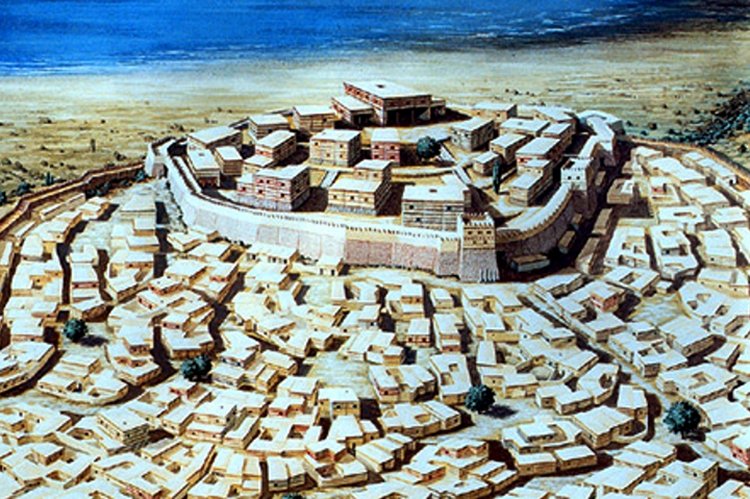 Reconstruction of Troy VIh/VIi (Wilusa of the Hittite text. Credits: Copyright by Christoph Haussner Munich
Reconstruction of Troy VIh/VIi (Wilusa of the Hittite text. Credits: Copyright by Christoph Haussner Munich
When the Trojan War began, Achilles was given the command of fifty ships, each containing 50 men. He engaged the services of five commanders-in-chief - Menesthius, Eudorus, Peisander, Phoenix, and Alcimedon. After they set sail for Troy, they accidentally landed in Mysia, where King Telephus ruled.
Telephus went to Achilles and was healed in exchange for directions to Troy.
A fight broke out with Achilles wounding Telephus, but the injury wouldn't heal, so Telephus consulted an oracle. He was told that only the person who caused the wound would be able to cure it.
The Iliad begins the narrative of the Trojan War when King Agamemnon attained a woman named Chryseis and enslaved her. Her father was a priest of the god Apollo, and she pleaded with him to aid his cause. Upon hearing this, Apollo sends a plague to curse the Greeks. Calchas informs Agamemnon of what caused this curse.
Reluctantly, Agamemnon agrees to give up Chryseis but only on the condition that Achilles hands his woman Briseis over to him. Achilles is outraged at the lack of respect and withdraws from the battle.
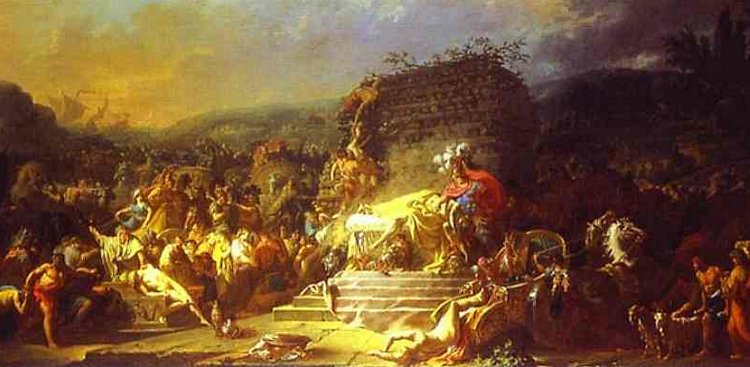 The Funeral of Patroclus - Jacques-Louis David
The Funeral of Patroclus - Jacques-Louis David
He visits with his mother, Thetis, and convinces her to ask Zeus to aid the Trojans so that he may demonstrate his worth in action once more. After this, the Trojans can push the Greeks back to shore.
Here, Patroclus, the friend of Achilles, puts on his armor without him knowing and commands the Myrmidons in a battle against the Trojans. However, he is slain by Hector, one of King Priam's sons. Achilles is enraged at Patroculus's death; he rejoins the Greeks on the battlefield and kills Hector. Subsequently, he ties Hector's body to his chariot throughout the funeral games held for his friend. As he lies about dying, Hector tells of how Achilles will die.
Hector's brother, Paris, shoots at the Greek hero, and the poisoned arrow lands in Achilles' one dead spot – his ankle.
According to other accounts, Apollo guided the arrow toward the Achilles heel. After Troy had fallen to the Greeks, his body was cremated and merged with the ashes of Patroclus.
Written by – A. Sutherland AncientPages.com Staff Writer
Updated on October 18, 2022
Copyright © AncientPages.com All rights reserved. This material may not be published, broadcast, rewritten or redistributed in whole or part without the express written permission of AncientPages.com
Expand for referencesSpara
Spara
More From Ancient Pages
-
 The Ancient Giants Who Ruled America: The Missing Skeletons And The Great Smithsonian Cover-Up
Biblical Mysteries | Apr 26, 2014
The Ancient Giants Who Ruled America: The Missing Skeletons And The Great Smithsonian Cover-Up
Biblical Mysteries | Apr 26, 2014 -
 Sacred Helgafell Mountain And The Story Of Torolv Mostrarskjegg
Myths & Legends | Mar 13, 2024
Sacred Helgafell Mountain And The Story Of Torolv Mostrarskjegg
Myths & Legends | Mar 13, 2024 -
 Glima – Ancient Martial Art Practiced By The Vikings Is Still Popular Today
Ancient Traditions And Customs | Mar 7, 2017
Glima – Ancient Martial Art Practiced By The Vikings Is Still Popular Today
Ancient Traditions And Customs | Mar 7, 2017 -
 15,000-Year-Old Shell Beads Found Kebara Cave Are The Oldest Known Use Of Organic Red Pigments
Archaeology | Oct 27, 2023
15,000-Year-Old Shell Beads Found Kebara Cave Are The Oldest Known Use Of Organic Red Pigments
Archaeology | Oct 27, 2023 -
 Sacred Hidden Buyan Island And The Mysterious Alatyr Stone With Healing Powers May Have Existed
Featured Stories | Mar 22, 2018
Sacred Hidden Buyan Island And The Mysterious Alatyr Stone With Healing Powers May Have Existed
Featured Stories | Mar 22, 2018 -
 Balkan Mountains’ Enigma – Strange Underground Anomaly Discovered
Featured Stories | Mar 30, 2025
Balkan Mountains’ Enigma – Strange Underground Anomaly Discovered
Featured Stories | Mar 30, 2025 -
 Giant 7,000-Year-Old Astronomical Calendar Discovered In Poland?
Archaeology | Dec 22, 2017
Giant 7,000-Year-Old Astronomical Calendar Discovered In Poland?
Archaeology | Dec 22, 2017 -
 Wreckage of The French Steamship That Sank In Atlantic In 1856 Found Off The Coast Of Massachusetts
Underwater Discoveries | Sep 23, 2024
Wreckage of The French Steamship That Sank In Atlantic In 1856 Found Off The Coast Of Massachusetts
Underwater Discoveries | Sep 23, 2024 -
 Mystery Of The Yaghan People: The First True Discoverers Of America?
Civilizations | Sep 19, 2016
Mystery Of The Yaghan People: The First True Discoverers Of America?
Civilizations | Sep 19, 2016 -
 The Untold Story Of The Inca – Fire In The Sky – Part 1
Ancient Mysteries | Jul 2, 2019
The Untold Story Of The Inca – Fire In The Sky – Part 1
Ancient Mysteries | Jul 2, 2019 -
 Headteacher’s Sarcophagus Unearthed In Ancient City Of Aigai, Turkey
Archaeology | Jan 25, 2017
Headteacher’s Sarcophagus Unearthed In Ancient City Of Aigai, Turkey
Archaeology | Jan 25, 2017 -
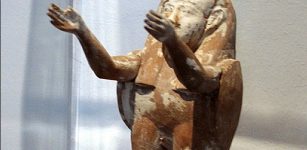 Ancient Beliefs About The Soul
Civilizations | Mar 8, 2016
Ancient Beliefs About The Soul
Civilizations | Mar 8, 2016 -
 Terracina – Ancient City Where Mythology And History Meet
Featured Stories | Jan 16, 2024
Terracina – Ancient City Where Mythology And History Meet
Featured Stories | Jan 16, 2024 -
 The Kitchen God In Ancient Vietnamese Tradition Is Still Alive
Featured Stories | Feb 23, 2016
The Kitchen God In Ancient Vietnamese Tradition Is Still Alive
Featured Stories | Feb 23, 2016 -
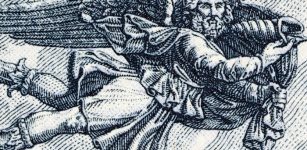 Boreas – Mighty North Wind God In Greek Mythology
Featured Stories | Mar 26, 2023
Boreas – Mighty North Wind God In Greek Mythology
Featured Stories | Mar 26, 2023 -
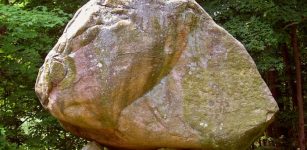 Mystery Of The Giant Boulder In North Salem
Featured Stories | Aug 8, 2019
Mystery Of The Giant Boulder In North Salem
Featured Stories | Aug 8, 2019 -
 Strange Ancient Artifact Found In New Jersey May Be Evidence Of A Long-Lost Advanced Civilization
Featured Stories | Jun 27, 2024
Strange Ancient Artifact Found In New Jersey May Be Evidence Of A Long-Lost Advanced Civilization
Featured Stories | Jun 27, 2024 -
 12,000-Year-Old Crater Dipsiz (‘Bottomless’) Lake, Searched For Gold, And Destroyed In Legal But Controversial Excavation
Archaeology | Nov 17, 2019
12,000-Year-Old Crater Dipsiz (‘Bottomless’) Lake, Searched For Gold, And Destroyed In Legal But Controversial Excavation
Archaeology | Nov 17, 2019 -
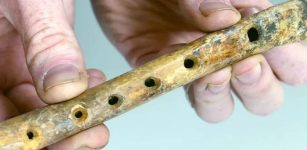 Rare, Well-Preserved Medieval Bone Flute Found In Kent
Archaeology | Nov 24, 2022
Rare, Well-Preserved Medieval Bone Flute Found In Kent
Archaeology | Nov 24, 2022 -
 The Apaches’ Mysterious Encounter With Unknown Beings
Featured Stories | Jun 10, 2024
The Apaches’ Mysterious Encounter With Unknown Beings
Featured Stories | Jun 10, 2024

